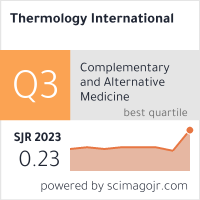American Academy of Thermology
Deutsche Gesellschaft für Thermographie & Regulationsmedizin
European Association of Thermology
Find volumes prior to 2012 in Archive
The effect of distance and angle of a smartphone-compatible infrared thermal imaging camera on skin temperature at the midportion of the Achilles tendon
Ben Oliver, Allan Munro, Lee Herrington
Salford University School of Health and Society, Manchester, United Kingdom
INTRODUCTION: With Achilles tendinopathy being a prevalent condition in both runners and the general population, infrared thermal imaging may be a useful tool for assessment. There is no standardised thermographic methodology when it comes to assessing the Achilles tendon, particularly the effect of distance and angle of an infrared thermal imaging camera on readings of skin temperature (TSK) at the midportion of the Achilles tendon is unknown.
METHOD: A sample of 7 participants recruited from the University Sport Rehabilitation course (4 male, 3 females; age 18.6 ± 1.6 years, height 173.7 ± 6.3cm, weight 73.8 ± 8.1kg) were used. Images were taken from 6 locations at 0.5m or 1m distances, at 0°, 7° or 14° angles, using a FLIR ONE smartphone-compatible infrared thermal imaging camera. Regions of interest (ROI) were selected retrospectively based on anatomical landmarks, using a custom freeform ROI tool.
RESULTS: No significant differences in Achilles tendon TSK were found between distances or angles. Effect sizes were trivial to small.
CONCLUSIONS: The FLIRONE infrared thermal imaging camera can be placed between 0.5m and 1m, perpendicular to the ROI at the centre of the limb or perpendicular to both ROI's at the midline of the body, without any significant variations in TSK.
KEYWORDS: Thermography, Achilles tendon, FLIR ONE
DER EINFLUSS VON ABSTAND UND WINKEL EINER SMARTPHONE-KOMPATIBLEN INFRAROTKAMERA AUF DIE AUSGELESENE HAUTTEMPERATUR ÜBER DER MITTE DER ACHILLESSEHNE
EINLEITUNG: Da pathologische Veränderungen an der Achillessehne sowohl bei Läufern als auch in der allgemeinen Bevölkerung weit verbreitet sind, kann die Infrarot-Thermographie ein nützliches Werkzeug für die Beurteilung sein. Für die thermographische Beurteilung der Achillessehne gibt es keine standardisierte Methodik, insbesondere ist die Wirkung von Entfernung und Winkel einer Infrarot-Wärmebildkamera auf die Auslesewerte der Hauttemperatur (TSK) über der Mitte der Achillessehne unbekannt.
METHODE: Eine Stichprobe wurde aus 7 Teilnehmern eines Universitätskurs für Rehabilitation im Sport (4 männlich, 3 weiblich; Alter 18,6 x 1,6 Jahre, Höhe 173,7 x 6,3 cm, Gewicht 73,8 x 8,1 kg) rekrutiert. Die Bilder wurden von 6 Positionen in 0,5m oder 1m Entfernung, in 0°, 7° oder 14° Winkeln mit einer FLIR ONE Smartphone-kompatiblen Infrarot- Wärmebildkamera aufgenommen. Die Ausmessflächen wurden rückwirkend anhand anatomischer Orientierungspunkte platziert, wobei ein Werkzeug zur Erstellung einer beliebig geformten Fläche verwendet wurde.
ERGEBNISSE: Die Hauttemperatur war nicht signifikant unterschiedlich, wenn die Achillessehne bei unterschiedlichen Abständen oder Winkeln abgebildet wurde. Effektgrößen waren trivial bis klein.
SCHLUSSFOLGERUNGEN: Die Infrarot-Wärmebildkamera FLIRONE kann in einem Abstand zwischen 0,5mund 1 m entweder normal zu einem Messareal in der Mitte der Extremität oder an der Körpermitte, normal zu zwei Messarealen platziert werden, ohne dass daraus signifikante Abweichungen in der erfassten Hauttemperatur entstehen.
SCHLÜSSELWÖRTER: Thermographie, Achillessehne, FLIR ONE
Thermology international 2020, 30(2) 51-57
